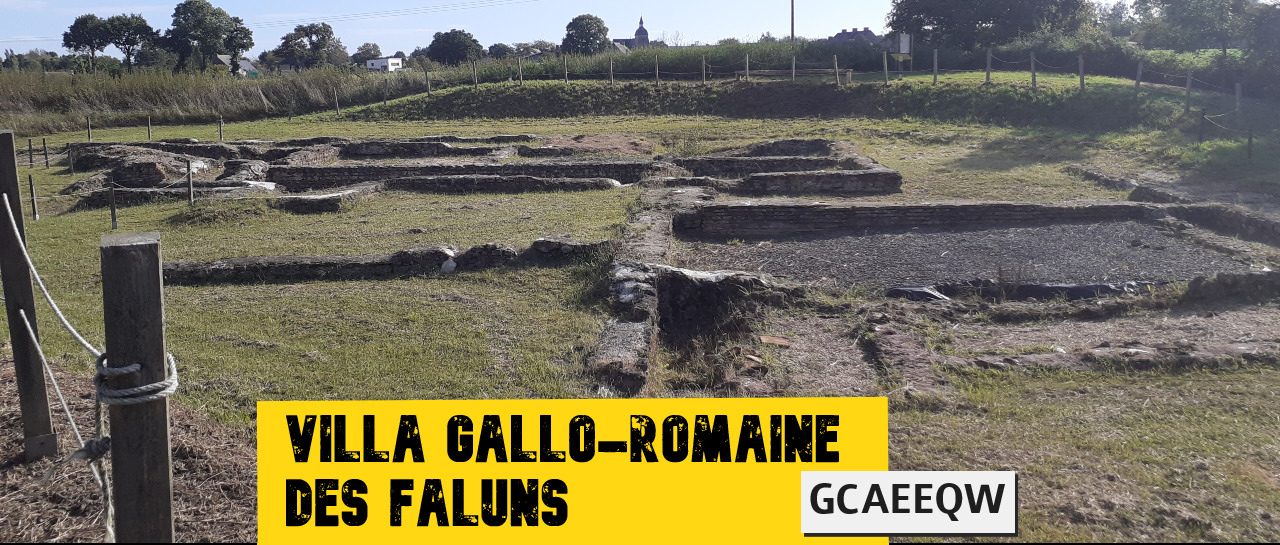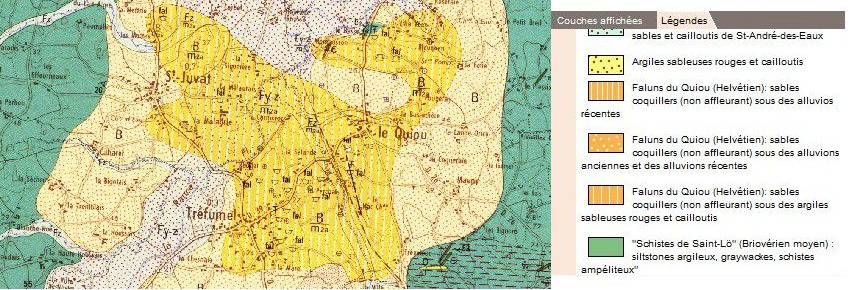
Le calcaire du Quiou s'est formé au Miocène dans la zone médiane de la Bretagne, par sédimentation, dans une matrice argilo-sableuse, d'algues calcaires et de coquillages présents dans la mer des Faluns qui faisait de l'Ouest de cette région une île en la séparant du reste du continent.
Quiou limestone was formed during the Miocene in the middle zone of Brittany, by sedimentation, in a sandy-clay matrix, of calcareous algae and shells present in the Falun Sea, which separated the western part of the region from the rest of the continent.

Le calcaire du Quiou se présente sous trois états typiques : sédiment meuble ; calcaire biodétritique ; roche consolidée. Dans ce dernier cas, il prend le nom de « pierre de Jauge » et a été utilisé depuis 2 000 ans comme pierre à bâtir ; broyé et cuit comme mortier de jointoiement et enduit à la chaux des murs. Ses teintes sont variées : beige, ocre-jaune, blanc-gris. Il est habituellement d'une densité moyenne en raison de petites alvéoles.
Quiou limestone comes in three typical states: loose sediment, biodetritic limestone and consolidated rock. In the latter case, it is known as "pierre de Jauge" and has been used for 2,000 years as building stone; crushed and fired as pointing mortar and lime plaster for walls. It comes in a variety of shades: beige, yellow-ochre, grey-white. It is usually of medium density, due to its small cells.

La villa gallo-romaine du Quiou, l'une des plus vastes d´Armorique connue à ce jour et les nombreux sites antiques repérés sur le territoire de la commune attestent d´un importante occupation des lieux des le 1er siècle de notre ère. Cette implantation romaine précoce pourrait être due à l´exploitation du calcaire coquillier utilisé pour la fabrication de la chaux et la construction des édifices : l´examen des édifices de la cité de Corseul montre l´emploi massif de ce matériau, bien qu´il se fasse relativement loin de son lieu d´extraction.
The Gallo-Roman villa at Le Quiou, one of the largest in Armorique to date, and the numerous ancient sites found in the commune, attest to a major occupation of the area from the 1st century AD. This early Roman settlement may have been due to the exploitation of shell limestone, used for lime production and building construction: an examination of the buildings in the town of Corseul shows the extensive use of this material, albeit relatively far from where it was extracted.
De nombreux sites gallo-romains ont été découverts sur le territoire du bassin du Quiou, qui faisait partie de la cité des Coriosolites, dont une autre villa, des thermes ruraux, ainsi que a voie romaine reliant Rennes à Corseul, la capitale de la cité. Dans cette dernière l'utilisation des pierres à chaux du Quiou a été mise en évidence, notamment au temple du Haut-Bécherel.
Numerous Gallo-Roman sites have been discovered in the Quiou basin, which was part of the city of Coriosolites, including another villa, rural thermal baths and the Roman road linking Rennes to Corseul, the city's capital. The use of limestone from Le Quiou has been demonstrated in Corseul, notably at the Haut-Bécherel temple.

L´association dans un ensemble cohérent d´une vaste habitation, d´un entrepôt à l´angle sud-est et de thermes privés à l´angle nord-est, en fait un exemple particulièrement intéressant pour l´histoire de la romanisation en Armorique. La découverte dans le bâtiment des thermes de fragments de décor peint au rouge de cinabre témoigne du luxe de cette grande habitation rurale.
The combination of a large dwelling, a warehouse in the southeast corner and private baths in the northeast corner makes this a particularly interesting example of Romanization in Armorica. The discovery of fragments of cinnabar-red painted decoration in the baths building testifies to the luxury of this large rural dwelling.
La villa gallo-romaine de la Gare, près du bourg du Quiou au sud de Dinan dans les Côtes-d'Armor, est connue depuis le 19e siècle. Un cliché, réalisé le 24 juin 1989 par Loïc Langouet (Centre Régional d'Archéologie d'Alet), montre le plan d'une villa rurale d'au moins un hectare et demi de superficie, une des plus grandes connues en Bretagne.
The Gallo-Roman villa of La Gare, near the village of Le Quiou south of Dinan in the Côtes-d'Armor region, has been known since the 19th century. A photograph taken on June 24, 1989 by Loïc Langouet (Centre Régional d'Archéologie d'Alet) shows the layout of a rural villa covering at least one and a half hectares, one of the largest known in Brittany.
Organisée autour de deux cours en enfilade, la partie ouest est occupée par l'habitat résidentiel caractérisé par une cour fermée d'environ 2000 m2 bordée sur les trois côtés par des bâtiments. La partie Est est moins bien conservée et son emprise est peu lisible sur le cliché de Loïc Langouët.
Organized around two adjoining courtyards, the western part is occupied by residential housing, characterized by an enclosed courtyard of around 2,000 m2 bordered on three sides by buildings. The eastern part is less well preserved, and is not clearly visible in Loïc Langouët's photograph.
Matériaux de construction / Building materials
La villa se situe au coeur d'une dépression renfermant des faluns meubles (sables coquilliers) parfois consolidés donnant un matériau propre à la taille (pierres de jauge). Ce sédiment reconnu sous les niveaux gallo-romains constitue le sous-sol du site et a été exploité pour l'amendement des terres et la construction (chaux et moellons). Enfin la terre riche en argile permet de créer sur place des éléments de terre cuite notamment pour la couverture.
The villa lies at the heart of a depression containing loose falun (shell sand), sometimes consolidated to produce a material suitable for stonecutting (gauge stones). This sediment, found beneath the Gallo-Roman levels, forms the subsoil of the site and was used for soil improvement and construction (lime and rubble). Lastly, the clay-rich soil was used to create terracotta elements on site, notably for roofing.
Questions
Question 1 - Aux coordonnées de la cache quels sont les matériaux que l'on peut encore observer sur place dans les constructions ? Dans quelle partie de la villa se trouve t'on ?
Question 2 - Au second waypoint (N 48° 21.012' W 2° 0.723') vous êtes à proximité d'un autre espace de la villa. Lequel est-ce ? Quels sont les matériaux qui sont encore visibles ?
Question 1 - At the coordinates of the cache, what materials can still be seen on site in the buildings? In which part of the villa are we?
Question 2 - At the second waypoint (N 48° 21.012' W 2° 0.723') you are close to another area of the villa. Which one is it? What materials are still visible?
Pour valider cette earthcache / To validate this earthcache
Rendez-vous aux coordonnées de cette earthcache répondre à la question d'observation (Q1) ainsi qu'à la question secondaire au second waypoint (Q2) et envoyez moi vos réponses.
Go to the coordinates of this earthcache to take a photo of yourself or one of your geocaching objects with the beach of Les Sables-d'Or in the background, and answer the questions asked.
Vous pouvez loguer cette cache "Found it" en n'oubliant pas la photo dans votre log (photo obligatoire) et m'envoyer vos réponses aux questions soit via mon profil, soit via la messagerie geocaching.com (Message Center), et je vous contacterai en cas de problèmes dans vos réponses.
Log in this "Found it" cache with your photo in your log and send me your answers either via my profile or via the geocaching.com (Message Center) mail, and I will contact you in case of a problem.
Pour rappel : il n'y a pas de boîte à trouver pour valider une earthcache ! Vous pouvez loguer votre découverte mais devez aussi m'envoyer vos réponses au plus vite.
To remind: there is no box to find to validate an earthcache! You can log your discovery but also send me your answers as soon as possible.